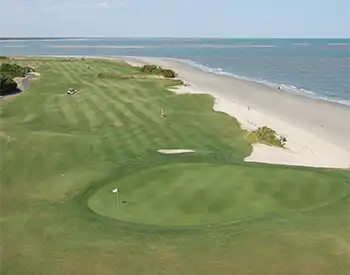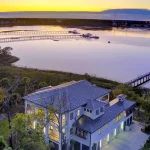
Hole 8 at The Links is one of the hardest to shoot under par. When Mike Gollobin moved from Virginia to Isle of Palms in 2014, he and his wife had many reasons prompting the relocation: the coastal environment, ocean breezes and a seaside lifestyle they had been planning for their retirement years.
But another factor was to live next to the Harbor Course and the Links Course – the two 18-hole golf courses at Wild Dunes. “The first time we came to Wild Dunes in 2004, we knew this was where we wanted to be,” Gollobin said. “And I’ve been playing here permanently since moving.”
Consistently noted by Golf Digest as one of the state’s best courses, the rolling fairways, varying hole spots and the tricky sea winds of Wild Dunes have been testing and frustrating golfers of all levels for 40 years. Now, with the Harbor Course undergoing a full $8 million renovation, anticipation is running high as to how the new course will eventually look – and play.

“This is the first renovation on this big of a scale since the 1985 opening,” said Terri Haack, managing director for Wild Dunes Resort. “Renovation will happen to varying degrees on all 18 holes.”
Golf pro Jeff Minton added that he for one is expecting the new look to mirror that of the Links.
“The Links Course underwent a similar renovation in 2015,” said Minton, who also serves as the director of golf/sports at Wild Dunes. “When the Harbor Course re-opens in November 2025, both courses will be an enjoyable experience for all levels of golfers for many years to come.”
Designed by Tom Fazio, the courses have recently been threatened by growing floodwaters and storms. The scope of work, which began March 3, will include rebuilding and enlarging greens and tee complexes, renovating cart paths and installing a new irrigation system to allow for more efficient golf course watering, leading to water conservation. “Holes 9 and 10 that parallel the Intracoastal Waterway will be raised in elevation to assist in seasonal tidal flooding,” Haack said.
The renovations are also expected to make the two already challenging courses even harder than before. For example, Gollobin, despite being president of the Wild Dunes Men’s Golf Association, and the club champion three of the last four years, said, “I’ve never had a hole-in-one in my life.”
Minton indicated Wild Dunes golfers are lucky just to shoot par. While the lowest recorded score on the Links Course is 63 and 61 on the Harbor Course, such rounds are rare.
“The Harbor Course’s 17th hole, for instance, is a 410-yard Par 4 that requires an accurate tee shot avoiding the marsh on the left and out of bounds on the right,” Minton said. “The second shot is just as difficult for golfers having to hit a long iron or fairway wood to reach the putting green with no room for errant shots either left or right of the putting green. Par is a great score on any of these holes.”
And Biff Lathrop, executive director with the South Carolina Golf Association in Columbia, added that the challenging play of Wild Dunes is only one attraction; the quality and conditions of both golf courses are just as vital.
“We currently have more than 350 golf courses throughout South Carolina, and golf is one of the biggest reasons people come to the Charleston area,” Lathrop said. “Golf accounts for over $3.3 billion in sales for the whole state, and the majority of those sales come from Charleston and all of our other coastal regions.”
So even if he never makes a hole-in-one, Gollobin said he doubts that he’ll ever be at home playing any other course than Wild Dunes.
“I’m a big fan of Tom Fazio, and I love his courses and magnificent layouts,” he said. “They’re not all tricked up – it’s what you see is what you get. But it’s still plenty challenging.”
By L. C. Leach III



Leave a Reply